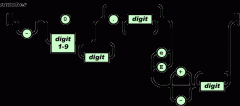写在前面:
文章翻译自petehunt大神的 petehunt/webpack-howto ,作为学习webpack的开始。fork了一份,翻译后的在这里 https://github.com/zjzhome/webpack-howto/blob/master/README-cn.md ,有些地方翻译的不好,也希望在阅读后对于不好的地方对出评论或者在github上提个issue。
本文目标本文讲述如何使用webpack将事情做好,包括了我们在Instagram做的大多数事情,我们没做的当然没有:)
我的建议:以此文作为学习webpack的开始,然后再阅读官方的文档说明。
预备知识和browserify类似,但可以将你的app划分为不同的文件。 如果你的单页应用你有多个页面,用户只需下载当前页的代码,如果他们离开此页浏览其他页面,不用再次下载那些通用的代码。
通常情况下可以替代grunt和gulp,因为webpack可以构建和打包CSS,预处理CSS、可以编译为JS的语言和图片等等。
webpack支持AMD和CommonJS以及其他的模块系统(Angular、ES6)。如果你不知道用哪种,使用CommonJS。
2、对于使用Browserify的童鞋下面的两个命令是等价的:
browserify main.js > bundle.js webpack main.js bundle.js不过,webpack比browserify更加给力,一般情况下,我们会创建 webpack.config.js 来保证条理性。
// webpack.config.js module.exports = { entry: './main.js', output: { filename: 'bundle.js' } };这完全是我们熟悉的JS,所以随意将挥洒你的代码。
3、如果调用webpack切换到包含 webpack.config.js 的目录, 运行:
webpack中和browserify转换器以及RequireJS中的插件等价的是 loader 。下面展示了如何让webpack支持加载CoffeeScript和Facebook JSX+ES6(你需要首先 npm install babel-loader coffee-loader )):
// webpack.config.js module.exports = { entry: './main.js', output: { filename: 'bundle.js' }, module: { loaders: [ { test: /\.coffee$/, loader: 'coffee-loader' }, { test: /\.js$/, loader: 'babel-loader' } ] } };为了在加载文件的时候不必生命文件扩展名,你必须加上 resolve.extensions 这个参数来告诉webpack该寻找哪些文件.
// webpack.config.js module.exports = { entry: './main.js', output: { filename: 'bundle.js' }, module: { loaders: [ { test: /\.coffee$/, loader: 'coffee-loader' }, { test: /\.js$/, loader: 'babel-loader' } ] }, resolve: { // you can now require('file') instead of require('file.coffee') extensions: ['', '.js', '.json', '.coffee'] } }; 5、样式和图片首先,在你的代码中使用 require() 来引入你的静态资源。
require('./bootstrap.css'); require('./myapp.less'); var img = document.createElement('img'); img.src = require('./glyph.png');当你引入CSS(或者less等),webpack会将CSS作为字符串打包到JS中,然后 require() 会在页面中插入 <style> 标签。当引入图片资源的时候,webpack会将图片地址打包进JS, require() 返回图片地址。
但是你要告诉webpack怎么做:
// webpack.config.js module.exports = { entry: './main.js', output: { path: './build', // This is where images AND js will go publicPath: 'http://mycdn.com/', // This is used to generate URLs to e.g. images filename: 'bundle.js' }, module: { loaders: [ { test: /\.less$/, loader: 'style-loader!css-loader!less-loader' }, // use ! to chain loaders { test: /\.css$/, loader: 'style-loader!css-loader' }, {test: /\.(png|jpg)$/, loader: 'url-loader?limit=8192'} // inline base64 URLs for <=8k images, direct URLs for the rest ] } }; 6、特征标识有些代码我们只想用在开发环境(比如日志)或者内部的服务器(比如处于内测的未发布产品特性)。在你的代码里,使用以下几个变量:
if (__DEV__) { console.warn('Extra logging'); } // ... if (__PRERELEASE__) { showSecretFeature(); }然后告诉webpack这些全局变量:
// webpack.config.js // definePlugin takes raw strings and inserts them, so you can put strings of JS if you want. var definePlugin = new webpack.DefinePlugin({ __DEV__: JSON.stringify(JSON.parse(process.env.BUILD_DEV || 'true')), __PRERELEASE__: JSON.stringify(JSON.parse(process.env.BUILD_PRERELEASE || 'false')) }); module.exports = { entry: './main.js', output: { filename: 'bundle.js' }, plugins: [definePlugin] };然后你可以在命令行里使用 BUILD_DEV=1 BUILD_PRERELEASE=1 webpack 命令构建,不过注意因为 webpack -p 命令会去清除无用的代码,所有抱在这些代码块里的代码都会被删除,所以不要泄露私密特性或字符串。
7、多入口假设你有一个用户资料页面和一个订阅页面,用户在浏览资料页面的你不想用户下载订阅页面的代码。所以要打多个包,为每一个页面创建一个“主要模块”(也叫作入口):
// webpack.config.js module.exports = { entry: { Profile: './profile.js', Feed: './feed.js' }, output: { path: 'build', filename: '[name].js' // Template based on keys in entry above } };对于资料页,在页面插入 <script src="build/Profile.js"></script> ,订阅页面也是一样。
8、优化通用代码
 相关文章
相关文章

 精彩导读
精彩导读 热门资讯
热门资讯 关注我们
关注我们
